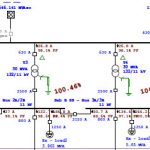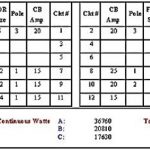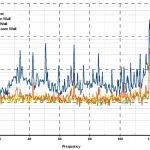
In an electric circuit the existing energy of a voltage supply decreases as electric current travels through the components that does not supply voltage i.e. passive elements of an electrical circuit. This is called Voltage Drop. Each point in a circuit can be assigned a voltage that’s proportional to its electrical elevation, so to speak. Voltage drop is simply the arithmetical difference between a higher voltage and a lower one. The National Electrical Code states that a voltage drop of 5% at the furthest receptacle in a branch wiring circuit is acceptable for normal efficiency
Why Perform Voltage Drop Study and Analysis?
Following are the harm caused by extensive voltage drop:
- Low voltage to the equipment being powered, causing improper, erratic, or no operation – and damage to the equipment.
- Poor efficiency and wasted energy.
- Heating at a high resistance connection/splice may result in a fire at high ampere loads.
One cannot determine exactly at what point voltage drop can cause fire, because it varies with the amount of current flowing through the high resistance connection, the resistance of that connection etc. Number of factors must be considered regarding at what point ignition will occur, example:
- Is the high resistance connection in connection with a flammable matter?
- Is there air flow to dissipate the heat?
- Is the area around the connection insulated, so that heat cannot escape?
Voltage drop study and analysis must be taken into consideration so that it may hardly affect the instruments. Like some household appliances that have a fixed capacity power engines are strongly influenced by voltage drop.
The main ways to reduce voltage drop are to:
- Increase power factor (add capacitors)
- Replace the conductor with a larger size.
What is Done During Voltage Drop Study and Analysis?
The reduction of any rate in the voltage leads to a rise in the current at the same rate and the problem is that this increase is often not huge. If we assume that this increase in the current was by 11%, it means that circuit breaker will not feel this increase and it will not operate while the device suffers from this increase in the current and thus leading to the increase in temperature gradually with time until it reaches the stage of the combustion. Another example the voltage drop by 1% lead to decrease in illuminance of tungsten lamp by 3%.
The amount of power delivered to a component in a circuit is equal to the voltage drop across that component’s terminals multiplied by the current flow through the component:
P = V*I
V = voltage drop in volts
I = current flow in amperes and
P =power in watts.
Obviously, if either V or I is zero, no power or energy is delivered to that component, so it can’t fulfil any useful purpose. So voltage drop is a vital feature of all electric circuits and is planned and controlled very carefully by the engineers that design those circuits.
So the transformers and the distribution boxes must be situated in a position such that maximum voltage drop from transformer to the furthest point doesn’t exceed 5% of the nominal voltage. lf it hard to find a place for the transformer so that maximum voltage drop is less than 5%, then we must use cables with larger cross-section area but It will increase the cost.
How is Voltage Drop Study and Analysis Done?
There are two methods by which voltage drop study and analysis can be done:
- Manual
- ETAP
Manual Voltage Drop Study and Analysis
Ohm’s Law Method – Single-Phase Only
Voltage drop of the circuit conductors is calculated by multiplying the complete resistance of the circuit conductors by the current through the circuit:
VD = I x R
I = Load in amperes
R = Resistance of the conductor
This method cannot be used for 3 phase circuits.
Voltage Drop Using the Formula Method
The voltage drop of circuit with already installed conductors can be calculated by:
VD = 2 * K * Q * I * D/CM – Single Phase
VD = 1.732 * K * Q * I * D/CM – Three Phase
VD = Volts Dropped
K = Direct Current Constant
Q = Alternating Current Adjustment Factor’
I = Amperes
D = Distance
CM = Circular-Mils
Electrical Transient Analyzer Programming (ETAP):
Since 1970s, ETAP has been a significant designing podium utilised for designing, analysing, and optimising electrical power systems. ETAP is a completely assimilated Electrical software solutions comprising of load flow, arc flash, short circuit and more. Its flexible performance makes it apt for all companies in any shape or form.
Operation Technology, Inc. is the developer of ETAP, the most wide-ranging analysis software for the simulation, design, operation, control, monitoring and automation of power systems. ETAP is the industry leader used worldwide in all types and sizes of power systems such as manufacturing, oil and gas, steel, mining, cement, and more.
We can approximate the voltage drop along a circuit as:
Vdrop= |Vs| – |Vr| ≈ IR·R + IX·X
Where, Vdrop= voltage drop along the feeder
R= line resistance
X= line reactance
IR= line current due to real power flow (in phase with the voltage)
IX= line current due to reactive power flow (90°out of phase with the voltage)
The biggest fault happens under leading power factor and heavy current. The approximation has an error less than 1% for an angle between the sending and receiving end voltages.
This estimation brings two crucial factors about voltage drop into the light:
Resistive load: At large power factors, the voltage drop is related directly to the resistance of the conductors. The resistance plays a crucial role, even though the resistance is generally less than the reactance.
Reactive load: At medium or small power factors, the voltage drop relates mostly to the reactance of the conductors. Because the reactance is usually larger than the resistance, the reactive load causes most of the voltage drop. Poor power factor significantly increases voltage drop.
Carelabs is authorized provider of Electrical Installation’s Study, Analysis, Inspection, and Certification services in UAE, and offer voltage drop study and analysis services.











